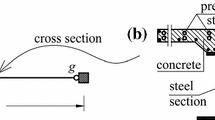Abstract
This paper considers some aspects of determining stiffness properties of cross-sections of bar elements and modeling the stress-strain states of bar systems. A method is proposed to find stresses based on nonlinear “stress-strain” dependencies. When numerically determining stiffness properties of a cross-section, a nonlinear analysis of a given collection of forces was performed. Using the method for performing nonlinear analysis, which is implemented in the software package “LIRA-SAPR,” the tangent and secant stiffness properties are determined. The methods proposed for determining and modeling stiffness properties allow to more precisely specify characteristics of nonlinear strain in materials and to apply them to elements of the cross-sections being designed.
Similar content being viewed by others
References
A. S. Gorodetsky, M. S. Barabash, and V. N. Sidorov, Computer Modelling in Problems of Building Mechanics [in Russian], ASV Publishing House, Moscow (2016).
M. S. Barabash, Computer Modelling of Life Cycle Processes of Construction Objects [in Russian], Stal’, Kyiv (2014).
V. A. Bazhenov, O. I. Gulyar, S. O. Pyskunov, and O. S. Sakharov, Semianalytic Method of Finite Elements in Problems of the Continual Destruction of Spatial Bodies [in Ukrainian], Karavela, Kyiv (2014).
I. A. Birger and Ya. G. Panovko (eds.), Strength, Stability, Fluctuations [in Russian], Vol. 1, Mashinostroeniye, Moscow (1968).
I. N. Molchanov, L. D. Nikolenko, and Yu. B. Filonenko, “Solution of the Neumann problem for the Poisson equation by the finite element method,” Computational and Applied Mathematics: Interdepartmental Scientific Compendium, Kyiv, Iss. 33, 137–143 (1977).
I. N. Molchanov, A. V. Popov and A. N. Khimich, “Algorithm to solve the partial eigenvalue problem for large profile matrices,” Cybernetics and Systems Analysis, Vol. 28, No. 2, 281–286 (1992).
A. N. Khimich, A. V. Popov and V. V. Polyanko, “Algorithms of parallel computations for linear algebra problems with irregularly structured matrices,” Cybernetics and Systems Analysis, Vol. 47, No. 6. 973–985 (2011).
E. A. Velikoivanenko, A. S. Milenin, A. V. Popov, V. A. Sidoruk, and A. N. Khimich, “Methods and technologies of parallel computing for mathematical modeling of stress-strain state of constructions taking into account ductile fracture,” Journal of Automation and Information Sciences, Vol. 46, Iss. 11, 23–35 (2014).
A. Yu. Baranov, A. V. Popov, Ya. E. Slobodyan, and A. N. Khimich, “Mathematical modeling of building constructions using hybrid computing systems,” Journal of Automation and Information Sciences, Vol. 49, Iss. 7, 18–32 (2017).
S. P. Timoshenko and J. N. Goodier, Theory of Elasticity [Russian translation], Nauka, Moscow (1975).
A. I. Lurie, Theory of Elasticity [in Russian], Nauka, Moscow (1970).
L. D. Landau and E. M. Lifshits, Theory of Elasticity [in Russian], Nauka, Moscow (1987).
W. Nowacki, Theory of Elasticity [Russian translation], Mir, Moscow (1975).
S. Yu. Fialko and D. E. Lumelskyy, “On numerical realization of torsion and bending problems for prismatic bars with arbitrary cross-sections,” Mathematical Methods and Physicomechanical Fields, Vol. 55, No. 2, 156–169 (2012).
O. C. Zienkiewicz, The Finite Element Method in Engineering Science [Russian translation], Mir, Moscow (1975).
A. N. Khimich, A. V. Popov, and A.V. Chistyakov, “Hybrid algorithms for solving the algebraic eigenvalue problem with sparse matrices,” Cybernetics and Systems Analysis, Vol. 53, N 6, 937–949 (2017).
A. S. Gorodetsky and M. S. Barabash, “Nonlinear behaviour of reinforced concrete in LIRA-SAPR software. Nonlinear Engineering method (NL Engineering),” International Journal for Computational Civil and Structural Engineering, Vol. 12, Iss. 2, 92–98 (2016).
M. S. Barabash, M. M. Soroka, and M. G. Suryaninov, Nonlinear Construction Mechanics with PC LIRA-SAPR [in Ukrainian], Ekologiya, Odessa (2018).
Author information
Authors and Affiliations
Corresponding author
Additional information
Translated from Kibernetika i Sistemnyi Analiz, No. 2, March–April, 2019, pp. 180–187.
Rights and permissions
About this article
Cite this article
Gorodetsky, O.S., Barabash, M.S. & Filonenko, Y.B. Numerical Methods for Determining Stiffness Properties of a Bar Cross-Section. Cybern Syst Anal 55, 329–335 (2019). https://doi.org/10.1007/s10559-019-00138-3
Received:
Published:
Issue Date:
DOI: https://doi.org/10.1007/s10559-019-00138-3




